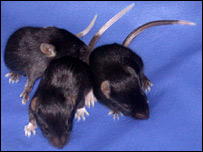Hologram Children
Virtual OffspringIt is change, continuing change, inevitable change, that is the dominant factor in society today. - Isaac Asimov
Source: Funny Times November 2001
Spotty Mice Flout Genetics Laws
Mice with the mutant gene have a white-tipped tail and white feet. by Rebecca Morelle Scientists say they have demonstrated that animals can defy the laws of genetic inheritance. Researchers found that mice can pass on traits to their offspring even if the gene behind those traits is absent. The scientists suggest RNA, a chemical cousin of DNA, passes on the characteristic - in this experiment, a spotty tail - to later generations. But more work may be needed to confirm the conclusions of the study, which appears in the journal Nature. The research focuses on a gene called Kit, which comes in two varieties: "normal" and "mutant". The mice inherit two Kit genes, one from each parent; a mutant version gives them a spotty tail. According to Mendel's laws of genetic inheritance, the combination of normal and mutant Kit genes inherited by the mice should alone determine whether the mouse has a spotted or unspotted tail. The scientists, based at the French Institute of Health and Medical Research (Inserm) and the University of Nice-Sophia Antipolis, used mice which carry one normal version of Kit and one mutant version, giving them spotted tails. They bred these mice together, producing offspring with a range of Kit gene combinations:
However, the researchers found that mice born with two normal versions of Kit also had a spotted appendage. "We were very surprised to see this," said Professor Minoo Rassoulzadegan, a geneticist at the University of Nice and lead author on the paper. After further investigation, the scientists suggested the transfer of RNA molecules as the cause. RNA is a polynucleotide, like DNA, and plays an important role in protein synthesis and in other chemical activity in the body. They found the mutant Kit gene produces large amounts of messenger RNA molecules (a type of RNA which acts as a template for the creation of proteins) which accumulate in the sperm of these mice. The scientists believe the RNA molecules pass from the sperm into the egg, and they "silence" the Kit gene activity in the offspring - even those who do not inherit a copy of the mutant gene. Silencing the activity in this gene leads to a spotted tail. "We then looked to see what would happen if a preparation of RNA from the sperm [of a mutant mouse] was injected into a fertilised mouse egg," explained Professor Rassoulzadegan. "It was clear when we saw the mice born after this injection that RNA could be responsible for the inheritance of the white tail phenotype." The phenomenon whereby the characteristic of a gene is "remembered" and seen in later generations, even if that particular version of the gene is no longer present, is called paramutation. It has previously been identified in plants, but this is the first time it has been shown in animals together with a proposed mechanism - if the explanation is confirmed in future experiments. "As the authors suggest, more experiments need to be done," commented Dr Andrew Hamilton, a molecular biologist from the UK's Glasgow University. "RNA-directed paramutation, which this study suggests, sounds very exciting, but I think major questions surrounding the gene specificity still remain," he told the BBC News website. In recent years researchers have amassed much circumstantial evidence to show that transmission of genes made of nuclear DNA is not the sole factor affecting inheritance. Could transfer of RNA in sperm explain other so-called epigenetic phenomena as well? That it could is hinted at in a commentary on the new research, also published in Nature, by Professor Paul Soloway from Cornell University in the US. "A particularly intriguing possibility," he writes, "is that such RNAs regulate other non-genetic modes of inheritance, such as metabolism or behavioural imprinting." The Nice-based team now plans to look for other characteristics in mice which can be transferred through RNA. But the eventual scope of research in this field may widen to include other organisms, including humans. "This brings valuable information about modification of our genome," said Minoo Rassoulzadegan, "and perhaps this research may eventually help us to understand why we are all so different from each other." Source: news.bbc.co.uk 24 May 2006 © BBC MMVI
From an article entitled "Forefathers' Smoking May Be Behind Today's Tubby Children" (telegraph.co.uk 12 June 2005) I read that the children of smokers tended to be fatter than average by the age of 9. Professor Marcus Pembrey of University College, London theorised that evolution came up with a way to help communities adapt to famine and adversity - when one generation is stressed, biological signals sent to later generations trigger faster growth and earlier puberty and reproduction. Is RNA the biological messenger that allows one generation to send messages to later generations at the cellular level? This is over and above the laws of genes and inheritance, which seems to be bound by relatively rigid laws. RNA appears much more fluid. Jean-Baptiste Pierre Antoine de Monet, Chevalier de Lamarck anyone?
For articles on bacteria, centrioles, chairs, nebulae, asteroids, robots, memory, chirality, pain, fractals, DNA, geology, strange facts, extra dimensions, spare parts, discoveries,
ageing and more click the "Up" button below to take you to the Index for this Science section. |
 Animals
Animals Animation
Animation Art of Playing Cards
Art of Playing Cards Drugs
Drugs Education
Education Environment
Environment Flying
Flying History
History Humour
Humour Immigration
Immigration Info/Tech
Info/Tech Intellectual/Entertaining
Intellectual/Entertaining Lifestyles
Lifestyles Men
Men Money/Politics/Law
Money/Politics/Law New Jersey
New Jersey Odds and Oddities
Odds and Oddities Older & Under
Older & Under Photography
Photography Prisons
Prisons Relationships
Relationships Science
Science Social/Cultural
Social/Cultural Terrorism
Terrorism Wellington
Wellington Working
Working Zero Return Investment
Zero Return Investment


